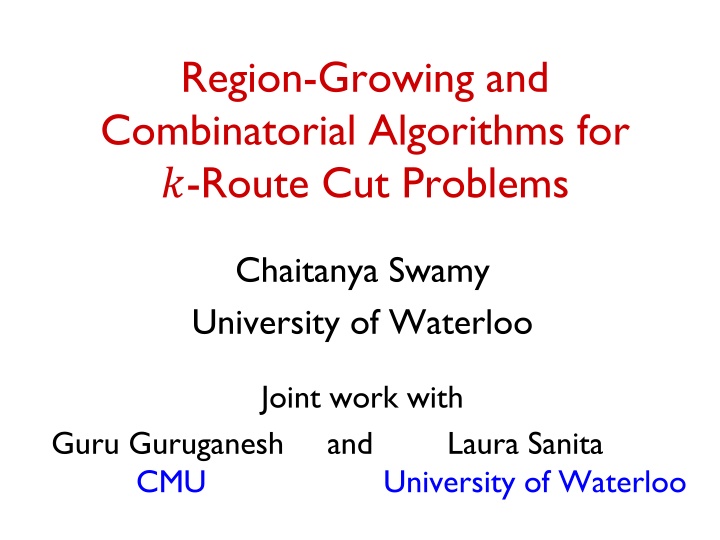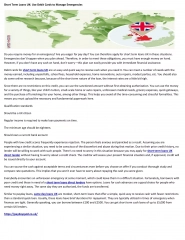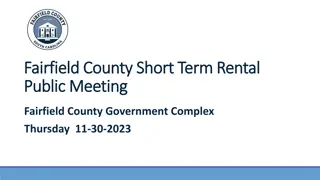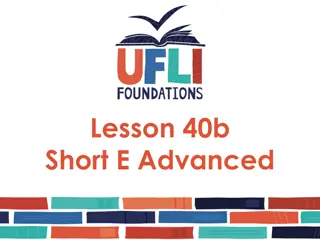
Cut Problems in Network Design: Region Growing and Combinatorial Algorithms
Explore the challenges and solutions of multicut problems in network design using region-growing and combinatorial algorithms. Learn about different types of cuts, feasible solutions, and the complexity of multicut and multiway cut problems. Discover the significance of ?-route cuts in enhancing network robustness and addressing network attacker scenarios.
Download Presentation

Please find below an Image/Link to download the presentation.
The content on the website is provided AS IS for your information and personal use only. It may not be sold, licensed, or shared on other websites without obtaining consent from the author. If you encounter any issues during the download, it is possible that the publisher has removed the file from their server.
You are allowed to download the files provided on this website for personal or commercial use, subject to the condition that they are used lawfully. All files are the property of their respective owners.
The content on the website is provided AS IS for your information and personal use only. It may not be sold, licensed, or shared on other websites without obtaining consent from the author.
E N D
Presentation Transcript
Region-Growing and Combinatorial Algorithms for ?-Route Cut Problems Chaitanya Swamy University of Waterloo Joint work with and Guru Guruganesh CMU Laura Sanita University of Waterloo
Multicut problem ?2 ?1 ??-?? pairs or commodities ?2 ?3 ?3 ?1 Given: graph ?, edge costs {??},commodities (?1,?1), ,(?? ,??) Find: min-cost set of edges whose removal disconnects every ??-?? pair
Multicut problem ?2 ?1 ??-?? pairs or commodities ?2 ?3 ?3 feasible multicut solution ?1 Given: graph ?, edge costs {??},commodities (?1,?1), ,(?? ,??) Find: min-cost set of edges whose removal disconnects every ??-?? pair ?-? cut problem: special case where ? = 1 multiway cut problem: special case where there is a set ? of nodes called terminals, every pair from ? forms a commodity Multicut and multiway cut are APX-hard Multicut: no ?(1)-approx. assuming unique-games conjecture
?-route multicut (?-MC) ?2 ?1 ??-?? pairs or commodities ?2 ?3 ?3 ?1 Given: graph ?, edge costs {??},pairs (?1,?1), ,(?? ,??), ? Find: min-cost set of edges whose removal renders every ??-?? pair at most (? 1)-edge connected (So 1-MC is the standard multicut problem)
?-route multicut (?-MC) ?2 ?1 ??-?? pairs or commodities ?2 ?3 feasible solution for 2-MC (i.e., ? = 2) ?3 ?1 Given: graph ?, edge costs {??},pairs (?1,?1), ,(?? ,??), ? Find: min-cost set of edges whose removal renders every ??-?? pair at most (? 1)-edge connected (So 1-MC is the standard multicut problem) ?-route ?-? cut (?-(?,?)-cut): ?-route multiway cut (?-MWC): ?-route version of multiway cut ?-route cut problems: at least as hard as 1-route counterparts ?-route version of ?-? cut
Motivation for ?-route cuts Abstract a network attacker s problem who seeks to reduce connectivity below a threshold ( standard cut problems model complete disconnection) Connections to network interdiction problems Arise as dual objects to ?-route flows ?-route flows: fault-tolerant version of flows where we pack tuples of k edge-disjoint paths; introduced by Kishimito (K96); recent applications in network design (CEV12) ?-route cut identifies bottleneck when we seek a certain level of robustness in the network All-pairs version of ?-MC (every pair of nodes is a commodity): special case of min-cost subgraph excluding a fixed minor constant-approximation known for node-deletion version with: unit node costs (FLMS12), arbitrary node costs for ? = 3 (FJP10)
?-route cut problems turn out to be much more challenging than 1-route counterparts (will see this) Significant difficulties arise in adapting techniques (e.g., region-growing, Racke-trees) for (1-route) cut problems Look for bicriteria guarantees: (?,?)-approx. means edge-set ? of cost ?(optimum) every ??-??pair is at most ?(? 1)-edge-connected after removing ?
Our results ?-(?,?)-cut is at least as hard as densest-?-subgraph (D?S) even on uniform hypergraphs Unicriterion ?(??0.polylog(?))-approx. for ?-(?,?)-cut for some constant ?0 improve the state-of-the-art for D?S on graphs, and prove the existence of a family of one-way functions (A11) Previously only NP-hardness was known; CMRZ12 prove similar hardness for vertex-connectivity version of ?-(?,?)-cut Marked difference with 1-route cuts; justifies bicriteria approx.
Our results ?-(?,?)-cut is at least as hard as densest-?-subgraph (D?S) even on uniform hypergraphs Unicriterion ?(??0.polylog(?))-approx. for ?-(?,?)-cut unlikely Previously only NP-hardness was known For ?-route multiway cut: Devise simple combinatorial algorithms that achieve approx. ? 1 ,? 1 for unit costs, ? 1 ,? ln ? for general costs approximation in connectivity approximation in cost
Our results ?-(?,?)-cut is at least as hard as densest-?-subgraph (D?S) even on uniform hypergraphs Unicriterion ?(??0.polylog(?))-approx. for ?-(?,?)-cut unlikely Previously only NP-hardness was known For ?-route multiway cut: Devise simple combinatorial algorithms that achieve approx. ? 1 ,? 1 for unit costs, ? 1 ,? ln ? for general costs Previous best for general ?: ? 1 ,? ln1.5 ? ? ln ? ,? ln3 ? for general costs; follow from guarantees for ?-MC (CMRZ12) (polylog(?)-approx. for ? = 2,3 (CK08, KS12)) for unit costs, All-pairs problem is NP-hard for all ? 3
Our results (contd.) For ?-route multicut, develop LP-rounding algorithms Get ?(ln ?.lnln ?)-approx. for 2-MC, and (? 1 ,? ln ?.lnln ? )-approx. for ?-MC with unit costs Improves upon corresponding guarantees in CMRZ12 by ?( ln ?)-factor in cost for any fixed connectivity violation Key technical ingredient: powerful region-growing lemma capable of handling multiple metrics (obtained from LP solution) can be exploited when using recursive region-growing without incurring ?(ln2 ?)-factor inherent in previous uses (BC11, KS11, KS12) of region-growing for ?-route cuts (which is worse than cost-approximation of ?(ln1.5 ?) in CMRZ12) obtain same savings as in other uses of standard region-growing in divide-and-conquer algorithms (ENRS00) potentially has other applications
?-MWC: combinatorial algorithm ? = ? 1?: terminal-set, ? = |?|, ??? = optimal value Basic insight: Let ? be a feasible solution. Then ? ? has a multiway cut with ? (? 1) edges (Proof: Find min ?1-?2 cut in ? ?; remove its edges and repeat.) Unit costs: ? has a multiway cut with ??? + ? (? 1) edges If ??? ? ? 1 then ?????? 2.???; Else, there is a terminal ? and ?-isolating cut with 4? edges cut separating ? from all other terminals
?-MWC: combinatorial algorithm ? = ? 1?: terminal-set, ? = |?|, ??? = optimal value Unit costs: ? has a multiway cut with ??? + ? (? 1) edges If ??? ? ? 1 then ?????? 2.???; Else, there is a terminal ? and ?-isolating cut with 4? edges Algorithm for unit costs: Repeat: If a current terminal ? has a ?-isolating cut (with respect to current terminals) with 4? edges, drop ?. Return near-optimal multiway cut for remaining terminals Gives a (4,4)-approx.; can get ?,? ? -approx. for any ? > 2 ? > 2 is necessary: have examples where every terminal has an isolating cut with 2? edges, but ??????= ? .???. (Pointed out by BC11: used similar approach for single-source ?-MC and suggested that this may not work for ?-MWC.)
?-MWC: combinatorial algorithm ? = ? 1?: terminal-set, ? = |?|, ??? = optimal value Unit costs: ? has a multiway cut with ??? + ? (? 1) edges Algorithm for unit costs: drop terminals until all terminals are sufficiently highly connected; return multiway cut of remaining terminals ??? ? General costs: will now incur cost ? get ? 1 ,? ln ? -approximation to drop a terminal Algorithm for gneeral costs: Set ?? = min ??,??? ? (? 1) edges ? has a multiway cut of ? -cost 2.??? Find terminal ? that has an isolating cut ? ? of ? -cost 4.??? Can write ? = ?1 ?2 with ? ?1 4.??? Add ?1 to solution, drop ?, decrease ?, and repeat. ? ?for all ? can bound ? -cost of the extra ? ? and ?2 4?
Linear program (LP) for ?-MC Let ??= collection of ??-?? paths ??: indicates if edge ? is cut ??? : indicates if edge ? lies on min ??-?? cut in remainder graph Minimize ? ???? subject to, ? ? (??+???) 1 ???? ? = ? 1 for all ? ?,? 0. (?) for all ?, ? ?? Let ???? = optimal value of (?) Theorem: Can round an optimal solution to obtain Feasible solution of cost ? ln ?.lnln ? .???? for 2-MC Solution of cost ? ln ?.lnln ? .???? where every ??-?? pair is ?(? ) edge connected for ?-MC with unit costs
Region growing Useful tool for cut problems: View LP solution as a metric Grow a suitable ball in this metric and show that: (cost of boundary edges) can be charged to (volume of ball) Min ? ???? (?) s.t. ? ? (??+???) 1 ?,? ?? ???? ? ? ?,? 0. (Subdivide each edge into ?-edge and ??-edges) contribution of edges (partly) inside ball to LP objective Main difficulties: LP solution yields a different metric for each commodity unlike almost all applications of region growing Can only charge to ?-edges (but looking at ?-metric is useless) Need to bound cost of ?-boundary and no. of ??-boundary edges
Region growing for ?-route cut Min s.t. ? ? (??+???) 1 ?,? ??; (Subdivide each edge into ?-edge and ??-edges) ? ???? (?) ???? ? ?; ?,? 0. For any ?, can find a suitable ball in (? + ??)-metric: (cost of ?-boundary) (no. of ??-boundary edges) = ?(?) = ?. (?-volume of ball) contribution of ?-edges (partly) inside ball to LP objective Not hard to show ? = ?(ln ?) (BC11) Can at best yield ?(ln2 ?)-approximation: Ball for ? can contain ?-connected ??-?? pairs, so need to recurse in each ball and re-use ?-edges in the ball ?(ln ?) levels of recursion ? ?.ln ? = ?(ln2 ?)-approx.
Our region-growing lemma Min s.t. ? ? (??+???) 1 ?,? ??; (Subdivide each edge into ?-edge and ??-edges) ? ???? (?) ???? ? ?; ?,? 0. Given a set ? of nodes, for any ?, can find ball in (? + ??)-metric: (cost of ?-boundary) =(?-volume of ball) x (no. of ??-boundary edges) = ?(?) ?(? volume of ?) ? volume of ball ? lnln ? .ln Nicely telescopes across levels of recursion (since ?-portion is common to all commodity metrics) get overall ?(ln ?)-factor ?(ln ?.lnln ?)-approx. Similar in spirit to ENRS00, but more general: deal with different (related) metrics, can only charge to ?-volume
Our region-growing lemma Min s.t. ? ? (??+???) 1 ?,? ??; (Subdivide each edge into ?-edge and ??-edges) ? ???? (?) ???? ? ?; ?,? 0. Given a set ? of nodes, for any ?, can find ball in (? + ??)-metric: (cost of ?-boundary) =(?-volume of ball) x (no. of ??-boundary edges) = ?(?) ?(? volume of ?) ? volume of ball ? lnln ? .ln Nicely telescopes across levels of recursion (since ?-portion is common to all commodity metrics) get overall ?(ln ?)-factor ?(ln ?.lnln ?)-approx. Similar in spirit to ENRS00, but more general: deal with different (related) metrics, can only charge to ?-volume
Rounding algorithm for 2-MC Given a set ? of nodes, for any ?, can find ball in (? + ??)-metric: (cost of ?-boundary) =(?-volume of ball)x ? lnln ? .ln (no. of ??-boundary edges) 1 ?(? volume of ?) ? volume of ball (*) 1. Start with ? all nodes, ? 2. If there is a 2-edge-connected ??-?? pair in ?: Pick such an ??-?? pair. Find a region ? around ?? or ?? satisfying (*) and containing at most half the pairs in ?. 3. Add all ?-boundary edges of ? to ?. 4. Repeat on ? ?, and ?. Disjoint ?-volume Recursive call: ?(ln ?) recursion depth Get ?(ln ?.lnln ?)-approximation.
Summary and open questions For ?-MWC, we get bicriteria guarantees. Can one get uncriterion ? ?.polylog ? -approx.? (Easy to get ?-approx. for ?-(?,?)-cut.) Even for unit-costs? Cannot avoid ??-factor For ?-MC, we get ? 1 ,? ln ?.lnln ? -approx. for unit costs Similar result for general costs? Conjecture: possible via LP and region growing Current best approx. is ? ln ? ,? ln3 ? (CMVZ12)
Summary and open questions cost of boundary edges of ? excluding ? 1 most expensive edges How well can one approximate following problem: All commodities share source ?; find ? ? minimizing When ? = 1, this is sparsest cut on star demand graph: can be solved exactly For general ?, best approx. is ? ln ? ,? ln ? -approx. by reduction to partial-cover version of multicut (CMVZ12) Can one get ? 1 ,? 1 approximation, maybe using LP for corresponding ? route cut problem? (When ? = 1, this is ? (?,?) cut easy to get (2,2) approx. here.) (?,?)-approx. (?,?.ln ?)-approx. for ?-route single- source cut ??? ?:?? ?






















